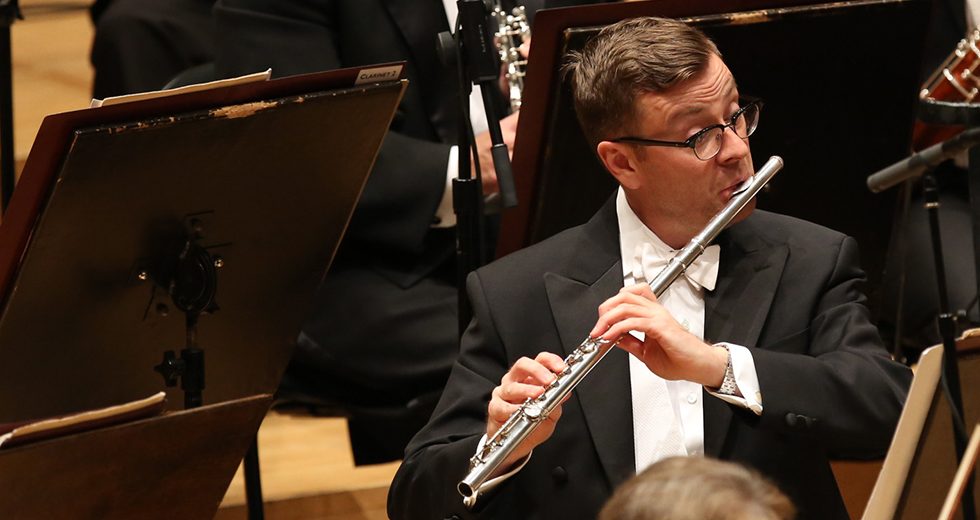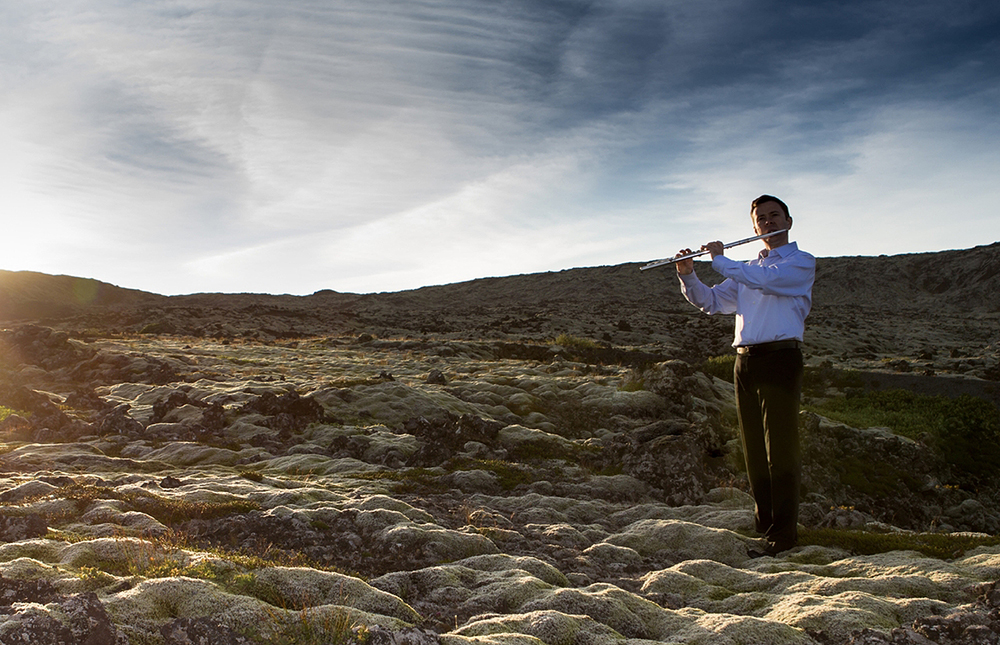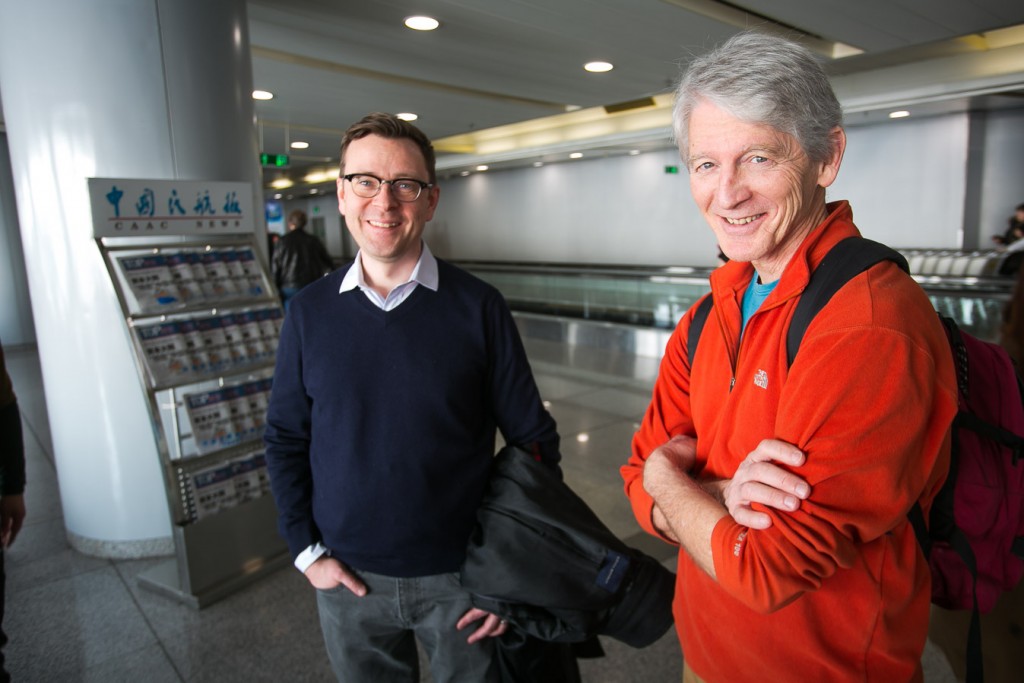
Eastern Iceland is another world. Mountains rise like giants from the ocean, deserted fjords are haunted by ghosts. In the winter, there is little daylight, in summer, no darkness. Icelandic mythology conjures images of elves, trolls, sea serpents. Humans are dwarfed by their surroundings.
“It is a special, magical place,” says Stefán Ragnar Höskuldsson (pronounced “HOS-culd-son”), principal flute of the Chicago Symphony Orchestra. Tiny fishing villages dot the landscape. Among them is Neskaupstaður, his hometown of just 1,000 inhabitants. “In my childhood I had total freedom,” he says. “There was just nature. No cinema, no restaurant. I wasn’t distracted by anything.”
For Höskuldsson, music and nature were inseparable. His father was a part-time organist in a local church, and also sang and played accordion. Outside, there was nature’s art, and inside, “there was always a lot of music and song in my household.”

For Stefán Ragnar Höskuldsson, the CSO’s principal flute, and native of Iceland, music and nature are inseparable. As a child he recalls “there was just nature. … I wasn’t distracted by anything.”
At the age of eight, Höskuldsson felt the shock of recognition. “I had a cousin in my small town that played the flute, and I had a lesson with her. I remember very clearly what that felt like. I loved the sound so much.” At first, he played only the flute’s headjoint, whistling joyfully, building the foundation of a “sound” that would be central to his musical life. Then for a year and a half, he taught himself.
Höskuldsson’s supportive, generous father was the spark for everything in his life. “My father didn’t want anything but the best for me.” True to form, he would drive his young son to Reykjavík for monthly lessons with Iceland’s pre-eminent flutist, Bernhard Wilkinson. This trip, from eastern to western Iceland, takes 11 hours. Each way.
Now in his early 40s, Höskuldsson still possesses a sweet, boyish charm. Neatly coiffed, with a careful side-part and stylishly retro browline glasses, he cuts a dapper figure. This gentle exterior hides an inner heat, released when the subject turns to music. Höskuldsson drops a layer of reserve, animates his arms, as if the music in his head has a physical aspect. He meets an interviewer’s eyes with a concentrated gaze.
“There is an intensity with which I like to play. I meditate on my material, try to get inside the music.” His practice carries a similar focus. First, foundation work: “I practice the skills, the sound, fingers, moving the fingers, articulation.” Then, there is just music: “I vocalize a lot, singing out loud, trying to get it as close to the heart of the music.”
In the CSO’s flute section, Höskuldsson is still, radiating focus, calm. For the CSO’s September concerts of Giuseppe Martucci’s luminous song cycle, La canzone dei ricordi, he played a duet with mezzo-soprano Joyce DiDonato. During those performances, his eyes keenly tracked DiDonato’s body. “I am trying to see every movement, where she is going with the phrase.” His playing shaded her every twist and turn with infinite finesse. “You have to flow, be ultimately flexible.”
Höskuldsson’s intensity was kindled by three main teachers, of whom he speaks in reverential tones. They loom large, each in his different way. Benny Wilkinson, his teacher for 11 years, was “a great musician, very demanding, the ultimate disciplinarian.” The two spent long hours together working on every detail of phrasing, technique and sound.“Benny opened my eyes to the vast world of music. We studied scores together and listened to many orchestral pieces, including old recordings of the Chicago Symphony.”
Peter Lloyd, a legendary English player, “took the French flute school to the maximum. … the finesse of his approach, in terms of sound color and lightness of articulation. We spent a whole year on articulation, to get it light enough.”
Wissam Boustany, however, was a true philosopher of the flute. “Wissam was a huge influence on me, he lit a fire. He is all heart, pushing us to go to the depths of expression, to go right to the source.” Improvising was essential. “If we are having a hard time with a piece of music, then improvise on the material to understand it better.”
Again and again, Boustany would ask his students, “Why is it that we play music?” For Boustany, there was no single way of being a musician, of making a career. He advised, “Take time to find your own voice.” After graduation, Höskuldsson took his advice, wandering Europe, playing competitions, finding his sound.

Stefán Ragnar Höskuldsson, then principal flute designate, and bass clarinet J. Lawrie Bloom await the flight to Seoul during the CSO’s 2016 Asian tour. | ©Todd Rosenberg Photography 2016
“I wanted to get my voice heard,” says Höskuldsson, who found that everywhere in Europe, he was rebuffed. He needed a change, a chance to redefine his career. When Höskuldsson, then 25, arrived in New York City in 2000, “I was lost. I tried to find jobs, played for people, met people, networked.” Needing money to live, he took work at the Flute Center of New York, a sales and repair shop in Columbus Circle.
“It was a difficult time,” Höskuldsson says. Six years passed between graduation and his first flute-playing job. Six years in the wilderness. Höskuldsson thinks that people don’t tell enough stories of struggle. “There are so many great, talented people going through that, but we don’t want to show weaknesses. People want to portray themselves in a very glamorous light,” but, in truth, “our strength lies in the way that we meet challenges.”
This period of Höskuldsson’s life sowed seeds of doubt. But one thing made him get up every morning: “My love for the sound. That’s all it boils down to. Sound is so basic, the fundamental thing.” This “sound” is at the core of his musical identity. It was with him as an 8-year-old in Iceland, it stayed by him through his studies in England, and it remained close during his journey in America.
Höskuldsson took several orchestral auditions in New York, and after two close calls, in 2004 he successfully auditioned for second flute of the Metropolitan Opera Orchestra, later moving to principal flute in 2007. Then, two lightning bolts struck from Chicago.
The first: Höskuldsson had “the good fortune” to work with Riccardo Muti, then the CSO’s music director designate, at the Met, in the 2010 production of Verdi’s Attila. “It was astounding. Maestro Muti opened the world of Verdi for me that I had not understood until he came along. It became a dream of mine to get to work with him again.” The second: Höskuldsson played with the CSO as guest principal flute, during which he was blown away by “this glorious, all-encompassing sound, colorful and rich.”
Now that he’s a crucial part of that orchestral voice, Höskuldsson is learning the ropes. “I’m finding my sound in the hall,” says the flutist, who officially took up the CSO post of the Erika and Dietrich M. Gross Principal Flute Chair in May 2016. “Learning how to fit in, understanding how to complement the orchestra’s sound while still having my own individual voice.”
In May 2015, two weeks before he auditioned for the CSO’s principal flute position, Höskuldsson went on a surprise birthday trip to Barcelona. “It was bought by my wife before I decided to take the audition.”
Something special occurred in Spain. Höskuldsson found himself absorbed by the art of Salvador Dalí (“whose imagination is endless”), by the food, by the surroundings.
“The beauty and art that exists in the world is what inspires me the most when I play,” he says. This brief holiday allowed Höskuldsson to “reflect on the music in the context of other forms of art and the beauty in nature.” He came back focused, relaxed, able to conjure these dazzling images during his audition on the stage of Chicago’s Orchestra Hall, using the most personal voice he possesses: the sound of his flute.
Tim Munro, a former member of the Chicago-based ensemble Eighth Blackbird, is a flutist, speaker, writer and teacher.